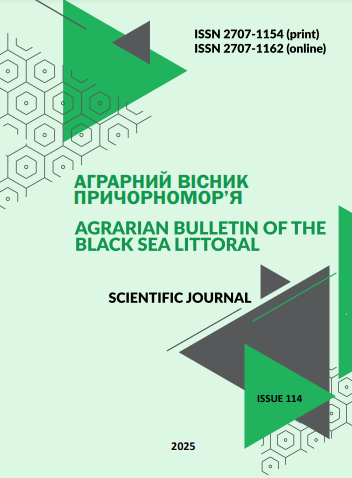SAFETY OF FISH PRODUCTS: EVALUATION OF CHEMICAL, BIOLOGICAL AND TOXICOLOGICAL RISKS
DOI:
https://doi.org/10.37000/abbsl.2025.114.07Keywords:
fish products, food safety, toxic elements, microbiological indicators, HACCP.Abstract
The article highlights the current issues of ensuring the safety of fish products under increasing requirements for food quality and growing consumer demand for healthy nutrition. Fish products are a valuable source of animal protein, polyunsaturated fatty acids, essential trace elements, and vitamins; however, they may pose a potential threat to human health in the case of microbiological contamination (presence of pathogenic microorganisms, toxins) or chemical contamination (accumulation of heavy metals, pesticide residues, dioxins, and other toxic substances).
The aim of the study was to assess the safety level of fish products through a comprehensive analysis of organoleptic, physicochemical, microbiological, toxicological, and radiological indicators, which allows for a thorough characterization of potential health risks to consumers.
The study examined the content of toxic elements (lead, cadmium, arsenic, mercury) in different types of fish—salmon, notothenia, saury, and herring. Variations in element concentrations depending on fish species were identified: the highest lead content was detected in salmon, and the highest arsenic content—in herring. Microbiological indicators included the analysis of total viable counts, coliform bacteria, and pathogenic microorganisms such as Salmonella spp. The results confirmed the overall compliance of the samples with current regulatory standards, confirming their sanitary safety.
The residual amounts of pesticides (HCH, DDT, and its metabolites), levels of radionuclides ( 137 Cs, 90 Sr), as well as ichthyopathological indicators were also analyzed.
The study emphasizes the importance of harmonizing national standards with European Union requirements regarding microbiological and toxicological safety criteria. Particular attention is drawn to the need for enhanced monitoring of heavy metal content depending on the geographical origin of the products.
An essential component of the safety management system is the implementation of HACCP principles at all stages of production and the dissemination of information to consumers regarding potential risks associated with fish consumption. The research results can be used in state control, and the development of food safety strategies.
References
FAO. The State of World Fisheries and Aquaculture 2022. Towards Blue Transformation. Rome: FAO, 2022. [Elektronnyi resurs]. Rezhym dostupu: https://doi.org/10.4060/cc0461en (data zvernennia: 11.03.2025).
Huss H.H., Ababouch L., Gram L. Assessment and management of seafood safety and quality: FAO Fisheries Technical Paper. No. 444. Rome: FAO, 2003. 230 p.
Schecter A., Colacino J., Haffner D., Patel K., Opel M., Päpke O., Birnbaum L.Perfluorinated compounds, polychlorinated biphenyls, and organochlorine pesticide contamination in composite food samples from Dallas, Texas, USAEnvironmental
Health Perspectives. 2010 Jun;118(6).Volume 118, Issue 6.796-802. doi: 10.1289/ehp.0901347.
Proderzhavnyikontrolzadotrymanniamzakonodavstvaprokharchoviprodukty, kormy, pobichniproduktytvarynnohopokhodzhennia, zdorovia ta blahopoluchchia tvaryn: Zakon Ukrainy vid 18.05.2017 № 2042-VIII.Vidomosti Verkhovnoi Rady Ukrainy. 2017. № 31. S. 343.
Pro zatverdzhennia Vymoh shchodo rozrobky, vprovadzhennia ta zastosuvannia postiino diiuchykh protsedur, zasnovanykh na pryntsypakh Systemy upravlinnia bezpechnistiu kharchovykh produktiv (NASSR): nakaz Ministerstva ahrarnoi polityky ta prodovolstva Ukrainy vid 01.10.2012 № 590 [Elektronnyi resurs]. – Rezhym dostupu: https://zakon.rada.gov.ua/laws/show/z1704-12#Text (data
zvernennia: 11.03.2025).
Matthee, M. (2007). The Codex Alimentarius Commission and its standards. [Doctoral Thesis, Maastricht University]. Maastricht
University.https://doi.org/10.1007/978-90-6704-515-5.
Pro osnovni pryntsypy ta vymohy do bezpechnosti ta yakosti kharchovykh produktiv: Zakon Ukrainy vid 23.12.1997 № 771/97-VR [Elektronnyi resurs]. – Rezhym dostupu: https://ips.ligazakon.net/document/Z970771?an=748971 (data zvernennia: 12.01.2025).
Schecter A., Colacino J., Haffner D., Patel K., Opel M., Birnbaum L. Perfluorinated Compounds, Polychlorinated Biphenyls, and Organochlorine Pesticide Contamination in Composite Food Samples from Dallas, Texas, USA // Environmental Health Perspectives. 2010. Vol. 118, Issue 6. P. 796–802. [Elektronnyi resurs]. – Rezhym dostupu: https://doi.org/10.1289/ehp.0901347 (data
zvernennia: 11.03.2025).
Schecter A., Colacino J., Haffner D., Patel K., Opel M., Birnbaum L. Polybrominated diphenyl ethers (PBDEs) and hexabromocyclododecane (HBCD) in composite U.S. food samples.Environmental Health Perspectives. 2009. Vol. 118, No. 3. P. 357–362. – [Elektronnyiresurs]. – doi:10.1289/ehp.0901345 (datazvernennia: 11.03.2025).
Pro Tsili staloho rozvytku Ukrainy na period do 2030 roku: Ukaz Prezydenta Ukrainy vid 30.09.2019 № 722/2019 [Elektronnyi resurs]. – Rezhym dostupu: https://zakon.rada.gov.ua/laws/show/722/2019#Text (data zvernennia: 11.03.2025).
Rykovska O., Fraier O., Mykhailenko O. Analiz stanu silskoho hospodarstva Ukrainy ta implementatsiia normatyvno-pravovykh aktiv YeS, dotychnykh do ahrarnykh ta dovkillievykh pytan. Kyiv: HO «Ekodiia», 2024. 22 s. – [Elektronnyi resurs]. – Rezhym dostupu: https://ecoaction.org.ua/wp-content/uploads/2024/03/analiz-stanu-sg-ua-ta-implement-es2024.pdf (data zvernennia: 11.03.2025).
Pro zatverdzhennia Hihiienichnykh vymoh do vyrobnytstva ta obihu kharchovykh produktiv tvarynnoho pokhodzhennia: nakaz Ministerstva ahrarnoi polityky ta prodovolstva Ukrainy vid 20.10.2022 № 813.[Elektronnyi resurs]. – Rezhym dostupu: https://zakon.rada.gov.ua/laws/show/z1409-22#Text (data zvernennia: 11.03.2025).
Pro rybne hospodarstvo, promyslove rybalstvo ta okhoronu vodnykh bioresursiv: Zakon Ukrainy vid 15.11.2024 № 3677-VI [Elektronnyi resurs]. – Rezhym dostupu: https://zakon.rada.gov.ua/laws/show/3677-17#Text(дата zvernennia: 11.03.2025).
Shvets T.V., Lisohurska D.V., Tymoshchuk T.M., Furman S.V. Vektory rozvytku zelenoho silskoho hospodarstva v Ukraini. Tavriiskyi naukovyi visnyk. 2024. № 137. S. 556-563. https://doi.org/10.32782/2226-0099.2024.137.65.
Downloads
Published
How to Cite
Issue
Section
License

This work is licensed under a Creative Commons Attribution-NonCommercial 4.0 International License.


